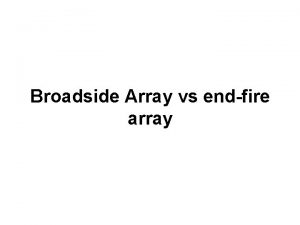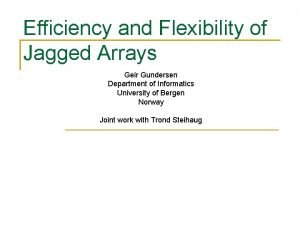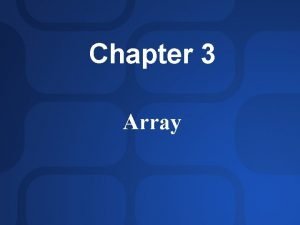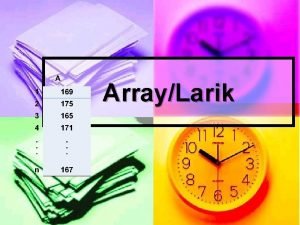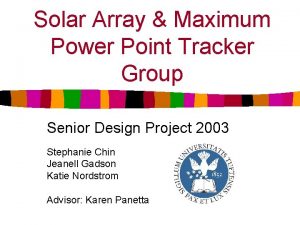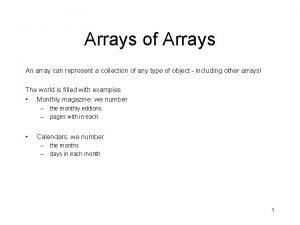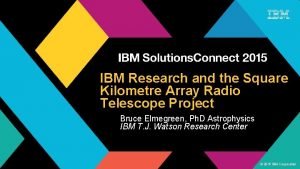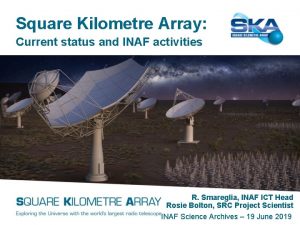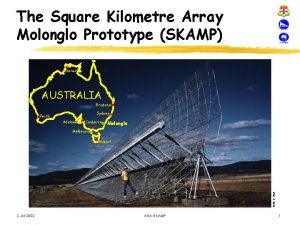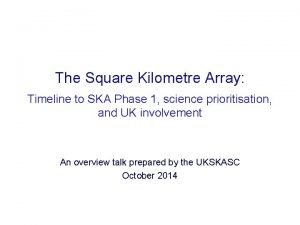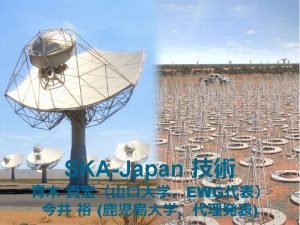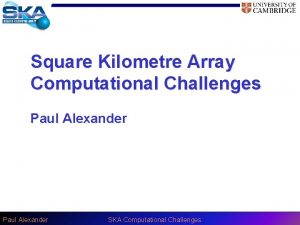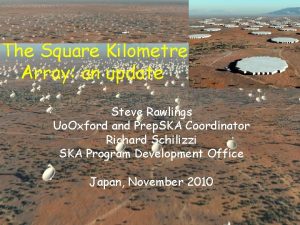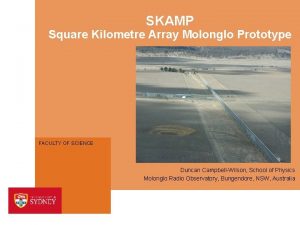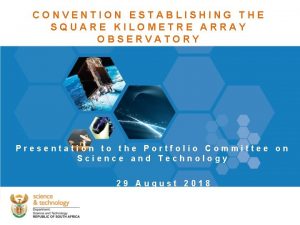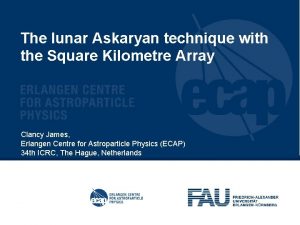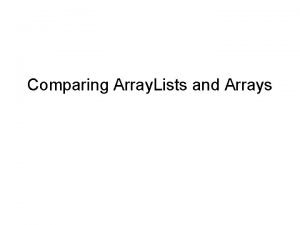The Square Kilometre Array Department of Astronomy and

























- Slides: 25

The Square Kilometre Array Department of Astronomy and Atmospheric Sciences, Kyungpook National University 김경묵, 박진태, 방태양, 신지혜, 조창현, 정수진, 현화수 Survey Science Group 3 rd Workshop 1

Outline < Section 2 > < Section 1 > � Introduction The Science � What is the SKA? � Extreme tests of general relativity � The SKA Timeline � How do Galaxies Evolve? Phase Development � What is Dark Energy? The SKA Telescopes � Around the re-ionization epoch! � Understanding Cosmic Magnetism � Cradle of Life : Searching for life and planets � � � Aperture Array The Properties of the SKA � Sky coverage & Resolution � Sensitivity & Depth � Data access Survey Science Group 3 rd Workshop 2

Introduction : What is the SKA? � The Square Kilometre Array � The largest, most sensitive radio telescope with an aim to provide fundamental answers to questions about the origin and evolution of the universe. � Telescopes will be co-located in Africa and in Australia. � South Africa(Karoo desert) : the high and mid frequencies. � Australia(Murchison region) : the low frequency and survey instrument. South Africa Australia (Image from the SKA official webpage) Survey Science Group 3 rd Workshop (Image from the SKA official webpage) 3

The SKA Telescopes Low Frequency Mid Frequency High Frequency (Image from the SKA official webpage) Telescope Freq. Range Collector Number & Size Distribution Low 70 MHz ~ 450 MHz Aperture array 250 arrays, D = 180 m 66% within 5 km diameter core 33% on 5 spiral arms to 180 km Mid 400 MHz ~ 1. 4 GHz Aperture array 250 arrays, D = 56 m 66% within 5 km diameter core 33% on 5 spiral arms to 180 km 2, 500 dishes, D = 15 m 50% 5 km diameter core 25% - core to 180 km, 25% - 180 km ~ 3, 000 km High 1. 2 GHz ~ 10 GHz Dishes Information from “https: //connect. innovateuk. org/web/ska/overview” Survey Science Group 3 rd Workshop 4

Aperture Array (AA) � AA is key feature of the SKA. � � AA is a large number of small, fixed antenna elements coupled to appropriate receiver systems. Advantages of AA � Unblocked aperture with full view of the entire sky! � Ultimate flexibility and reliability - no moving parts! � Beams are formed and controlled electronically! � Multiple beams (or FOV) permits concurrent, independent (or associated) observations → huge FOV! (http: //ska-ptafrica. org) Low Frequency AA Mid Frequency AA (Image from the SKA official webpage) Survey Science Group 3 rd Workshop 5

The SKA Timeline (Image from the SKA official webpage) Survey Science Group 3 rd Workshop 6

Phased Development � SKA Phase 1 (2018~) South Africa Australia HIGH (http: //ska-ptafrica. org) Survey Science Group 3 rd Workshop 7

Phased Development � SKA Phase 2 (mid 2020 s) South Africa Australia HIGH (http: //ska-ptafrica. org) Survey Science Group 3 rd Workshop 8

The Telescope Scale comparison (Image from the SKA official webpage) Survey Science Group 3 rd Workshop 9

The Properties of Instruments Survey Science Group 3 rd Workshop 10

Sky coverage & Resolution � Sky coverage � � The SKA Phase 1 shall be able to provide access to at least 2π sr of the sky. Resolution � Angular resolution is about to < 0. 1 arcsecond at 1. 4 GHz � ~3000 km base line Survey Science Group 3 rd Workshop 11

Sensitivity & Depth � The typical survey’s depth is z∼ 0. 2 with massive galaxies detected out to z∼ 0. 7. � SKA will have sufficient sensitivity to detect all QSOs and starforming galaxies to z~20. � ~ 50 times more sensitive than the currently most powerful interferometer. � The structure of the universe would be sampled over scales of 10’s of Mpc to several Gpc. Depth Sensitivity (https: //connect. innovateuk. org/web/ska/ov erview) Survey Science Group 3 rd Workshop (Taylor, A. R. et al. 1999) 12

Data access Optical fibres will be essential to transport the huge amount of data to the central SKA processor. (Image from The Aperture Arrays for the SKA: the SKADS White Paper 4. 2010. ) Survey Science Group 3 rd Workshop 13

Data access Optical fibres will be essential to transport the huge amount of data to the central SKA processor. (Image from The Aperture Arrays for the SKA: the SKADS White Paper 4. 2010. ) Survey Science Group 3 rd Workshop 14

The Science Survey Science Group 3 rd Workshop 15

The Key Projects � � � Extreme tests of general relativity How do Galaxies Evolve? What is Dark Energy? Around the re-ionization epoch! Understanding Cosmic Magnetism Cradle of Life : Searching for life and planets (Image from the SKA official webpage) Survey Science Group 3 rd Workshop 16

Extreme tests of general relativity � Was Einstein right or will general relativity eventually fail? � What are the properties of black holes? � Are there still ripples in space-time from the early Universe? � The SKA will test general relativity extremely with pulsars and black holes. The best test so far of Einstein’s theory in strong gravitational fields is provided by the only known double pulsar system, where two pulsars orbit each other in 145 min. Pulsars orbiting black holes will test Einstein’s description of these enigmatic objects to the extreme. (Image from the SKA Brochure) Survey Science Group 3 rd Workshop Pulsars discovered and monitored with the SKA will act like a cosmic gravitational wave detector, allowing the study of ripples in the fabric of space-time that propagate at ultralow frequencies. 17

How do Galaxies Evolve? � Radio telescopes’ ability to “see” regions beyond the optical view of a galaxy, have brought significant insights into how galaxies form and develop. � The SKA’s sensitivity and resolution will be able to track young, newly forming galaxies at cosmological distances, and, through mapping the distribution of H. (Image from the SKA official webpage) Survey Science Group 3 rd Workshop 18

What is Dark Energy? � Mysterious force appears to counteract and even surpass the mutual gravitational attraction causing acceleration in the expansion. � cosmology and dark energy is to observe the gravitational effects of galaxies and clusters of galaxies on the path of radio waves through the Universe. (Image from the SKA official webpage) Survey Science Group 3 rd Workshop 19

Around the re-ionization epoch! � Take snapshots of the 21 cm emission at many different epochs, before, during and after reionisation, yielding detailed information about the formation of the first structures in the universe. � But! these objects are exceptionally faint and much of their light is absorbed by intervening matter as it travels toward us. SKA can resolve this problem thanks to it’s very high sensitivity! � Through multifrequency observations, we can therefore construct fully threedimensional maps of neutral gas in the universe. � Such maps are crucial for studying the time dependence of reionisation. Survey Science Group 3 rd Workshop 20

Around the re-ionization epoch! (Furlanetto et al. 2003) Survey Science Group 3 rd Workshop 21

Understanding Cosmic Magnetism � What is the shape and strength of the magnetic field in our Milky Way? � How does this compare to the magnetism in other galaxies? � What role has this had on the formation of individual stars and galaxies? � Where and how do the magnetic fields originate? (Image from the SKA official webpage) (Image from Philipp P. Kronberg, Physics Today, 12. 2002, p. 30) Survey Science Group 3 rd Workshop 22

Cradle of Life : Searching for life and planets � The SKA will detect thermal emission from dust in the habitable zone. In particular, the SKA will show where dust evolves from micron-sized insterstellar particles to centimetre-sized and larger “pebbles”. � Astrobiologists will use the SKA to search for amino acids, the building blocks of life, by identifying their spectral signatures at specific frequencies. � The SKA will be able to detect extremely weak extraterrestrial radio signals if they were to exist. (Image from the SKA official webpage) Survey Science Group 3 rd Workshop 23

Reference � � Papers � Furlanetto, S. R. , & Loeb, A. 2003, AJ, 588, 18 � Nadin, Maureen et al. 2011, JRASC, 105, 15 � Kronberg, P. P. , Physics Today, 12. 2002, p. 30 � Taylor, A. R. 1999, in M. P. van Haarlam (ed. ), Perspectives on Radio Astronomy : Science with Large Antenna Arrays, ASTRON, p. 1 � The Aperture Arrays for the SKA: the SKADS White Paper (2010. 4) Webpages � The SKA official Webpage (https: //www. skatelescope. org) � The SKA Technology subgroup (https: //connect. innovateuk. org/web/ska/) � Workshop webpage � The Square Kilometre Array: a large Scale ESFRI Infrastructure, From the Cosmos to the Cities of the future (http: //ska -ptafrica. org/index. html) Survey Science Group 3 rd Workshop 24

Survey Science Group 3 rd Workshop 25
 Hm dam m dm cm mm
Hm dam m dm cm mm Learning astronomy by doing astronomy
Learning astronomy by doing astronomy Learning astronomy by doing astronomy activity 7 answers
Learning astronomy by doing astronomy activity 7 answers Learning astronomy by doing astronomy activity 1 answers
Learning astronomy by doing astronomy activity 1 answers Pin grid array and land grid array
Pin grid array and land grid array Endfire array
Endfire array Tugascout
Tugascout Jagged array vs multidimensional array
Jagged array vs multidimensional array Associative array vs indexed array
Associative array vs indexed array Apa itu larik
Apa itu larik Upper triangular array adalah
Upper triangular array adalah Multidimensional array python
Multidimensional array python Photovoltaic array maximum power point tracking array
Photovoltaic array maximum power point tracking array Magic square wrap around array java
Magic square wrap around array java Square numbers up to 12
Square numbers up to 12 11-20 squares
11-20 squares Square roots
Square roots Astronomy questions and answers multiple choice
Astronomy questions and answers multiple choice Msu physics and astronomy
Msu physics and astronomy Under root
Under root 16 square punnet square
16 square punnet square Square table 1 to 30
Square table 1 to 30 The area of a square is 144144144 square centimeters.
The area of a square is 144144144 square centimeters. Hát kết hợp bộ gõ cơ thể
Hát kết hợp bộ gõ cơ thể Ng-html
Ng-html Bổ thể
Bổ thể





